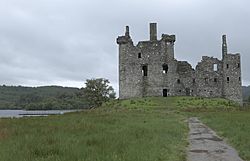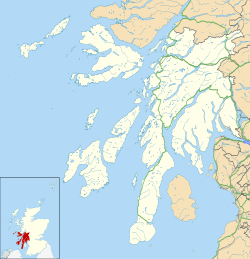Kilchurn Castle facts for kids
Quick facts for kids Kilchurn Castle |
|
|---|---|
| Argyll and Bute in Scotland | |

Kilchurn Castle
|
|
|
Location in Argyll and Bute
|
|
| Coordinates | 56°24′13″N 5°1′44″W / 56.40361°N 5.02889°W |
| Type | Castle |
| Site information | |
| Owner | Historic Environment Scotland |
| Open to the public |
Yes |
| Condition | Ruined |
| Site history | |
| Built | 15th century |
| Built by | Clan Campbell |
| In use | 15th century-1760 |
| Fate | Renovated frequently, destroyed by lightning |
Kilchurn Castle is a ruined castle found on a rocky piece of land at the top end of Loch Awe in Argyll and Bute, Scotland. It was first built in the mid-1400s. It served as the main home for a powerful family called the Campbells of Glenorchy.
Over the next 150 years, the Campbells made the castle bigger and also expanded their land. Later, the Campbells became very important and moved to Taymouth Castle. Kilchurn Castle was then used less and less. By 1770, it was already a ruin. Today, Historic Environment Scotland looks after the castle. You can visit it during the summer months.
Contents
Building Kilchurn Castle
The Campbells of Glenorchy were a very strong part of the larger Clan Campbell. From the 1430s onwards, they grew to control much of the central Highlands. Building several castles, like Kilchurn, was a key part of their plan to gain more land.
Sir Colin Campbell, who died in 1475, was a younger son of a powerful leader. He was given land in Glen Orchy in 1432. Around 1450, Sir Colin started building Kilchurn Castle. The first castle had a five-story main tower, called a tower house. It also had a courtyard protected by an outer wall. Back then, Kilchurn was on a small island in the loch. People likely reached it by a low path that was sometimes underwater.
Castle Changes Over Time
Sir Colin's son, Sir Duncan Campbell, added a "laich hall." This was a single-story dining hall built inside the south wall of the courtyard. Sir Duncan was one of many Scottish nobles who died in a big battle called the Battle of Flodden in 1513.
Later, in the second half of the 1500s, another Sir Colin Campbell made the castle even better. He added more rooms north of the main tower. He also updated the top part of the walls, adding round towers at the corners. This Sir Colin also built Balloch Castle, which is now Taymouth Castle. This helped the Campbells control more land in a different area.
"Black Duncan" and New Additions
Sir Duncan Campbell, known as "Black Duncan," lived from about 1550 to 1631. He was an important figure in Scottish politics. In 1614, he rebuilt and made the south part of the castle larger. He also added a new section with a chapel in the southeast part of the courtyard. Black Duncan was very ambitious. He also started building Finlarig Castle and improved farming land around his castles.
Kilchurn as a Barracks
In 1681, Sir John Campbell became the Earl of Breadalbane and Holland. He was very clever and used the changing times to his advantage. He talked with rebels who supported the old king, while also serving the new King William III.
In the 1690s, he started a plan to bring peace to the Highlands. As part of this, he began changing Kilchurn into a modern army barracks. It was designed to hold 200 soldiers. He added a large, L-shaped building with three stories along the north side.
In 1714, after Queen Anne died, Breadalbane held a meeting of rebels at Kilchurn. He then joined a rebellion in 1715. When the rebellion failed, he returned home. He found that people who supported the government had taken over Kilchurn and Finlarig castles. He had to give up to them in 1716. Kilchurn was also used by the government army during another rebellion in 1745. The Campbells tried to sell Kilchurn to the government, but they were not successful.
The Castle Becomes a Ruin
In 1760, a lightning strike badly damaged Kilchurn Castle. After this, it was completely left empty. You can still see parts of a tower that fell upside down in the courtyard, showing how powerful the storm was. By 1770, the castle had no roof.
A famous artist named J. M. W. Turner painted the castle in the early 1800s. In 1817, the water level in Loch Awe changed. This made the castle stand on a long piece of land instead of a small island.
Today, Historic Environment Scotland cares for the castle ruins. You can visit it in the summer. You can get there by boat or by walking from the A85 road. Sometimes, if the loch water is very high, the castle becomes a temporary island again. Kilchurn Castle is a protected historic site.
Images for kids
See also
 In Spanish: Castillo de Kilchurn para niños
In Spanish: Castillo de Kilchurn para niños









